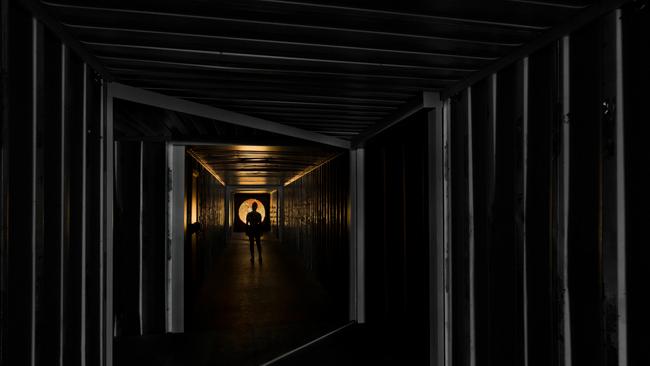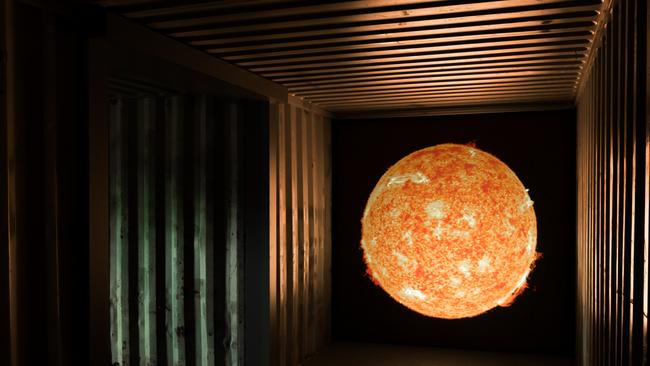Biennale of Sydney, Cockatoo Island: nothing means anything any more
The title, and the premise, of this year’s Sydney Biennale illustrate just what’s wrong with the world of art curation today.

As we approached Cockatoo Island on the ferry on a scorching Sunday afternoon, my 12-year-old daughter and astute research assistant asked me what the title of the 21st Biennale of Sydney exhibition meant. Superposition: Equilibrium and Engagement.
Oh nothing really, I said. In fact, you can make up your own title on this model by choosing any three polysyllabic abstractions and putting a colon after the first and a conjunction between the others. Equilibrium: Superposition and Engagement. Engagement: Equilibrium and Superposition. Ask yourself what would change and whether anyone would even notice.
The short essay by this year’s curator in the exhibition handbook confirms the vacuity and the ultimate cynicism that lie behind such a title. Superposition is meant to be an allusion to quantum mechanics, but there is a long history of scientific concepts eagerly and fallaciously borrowed as cultural metaphors. When the author describes electrons as substances, we know we’re on shaky ground, and it doesn’t get any better from there.
Even less impressive, but typical of the chronic lack of intellectual rigour in contemporary art writing, was the list of issues, or “conceptual levels”, that this Biennale was meant to address, from “Mother Earth” to “land ownership”: activists, theorists and hippies were all included.
Of more serious concern was the extraordinary suggestion that all the competing and seemingly incompatible forces affecting human life today ultimately resolve themselves into some “state of equilibrium”.
Equilibrium is a desirable moral and mental state to cultivate in oneself, but it is hardly the state of affairs that reigns in the world today: whether in the turmoil of political life around the world, in the vast economic disparities between people or the daunting environmental problems that we face — or even in the mental and physical health of populations in the most prosperous countries — we clearly find ourselves in a state of extreme disequilibrium. The curator’s anodyne observations about the state of the world only remind us how severed from reality the theme park of contemporary art has become.

The fact the most interesting part of the exhibition is always at Cockatoo Island reinforces this impression. The island itself is a remarkable site of industrial archeology, and since it was first adopted by the Biennale it inevitably has supplemented the interest of the work displayed there, and often compensated for its blandness. The part of the exhibition shown at the Museum of Contemporary Art, for example, is hardly exciting, and there is nothing in an empty gallery space to relieve the boredom of second-rate international art.
Even at Cockatoo Island, however, this year’s curator and the exhibiting artists don’t seem to have made the best use of the site. Most of the works exhibited are simply set in the spaces, rather than connecting with them in an interesting manner. Hardly anything seems to have been conceived with these specific spaces in mind.
The first work we encountered was a case in point: Julian Abraham Togar’s Diabethanol installation had no relation whatsoever to its environment and, considering its subject and aesthetic, could have been more effective in a blank gallery environment than in one full of adventitious and distracting character.
But it proved to be one of the more interesting works in the exhibition, based on the conceit that the urine of diabetics could be processed into bioethanol, so that they would be useful rather than a burden on the healthcare system. The humour is somewhat heavy-handed and rather tasteless, but it is a response to a widespread health problem in Indonesia and around the world.
A little further on we came to the star work in the exhibition, over which journalists and commentators have duly dribbled with admiration. It is by the celebrated art entrepreneur and supreme opportunist Ai Weiwei, who ingeniously has found a way to turn distressed migrants and refugees into biodiesel to fuel his own art career.

Ai was given his first big break by the Chinese government when it confiscated his passport. And just as the routine of the dissident martyr was starting to wear thin he got lucky again. He was able to latch on to the tragic death of children at sea, and soon achieved new heights of success. In the world’s present state of equilibrium, the migrant crisis is a subject that, like painting the Harbour Bridge, should occupy him comfortably for the rest of his career.
For the Biennale, Ai’s art factory has produced a vast rubber dinghy filled with hunched-over rubber figures. The work is on a vast scale to make us understand what an important and ambitious artist Ai is. The work is so big, in fact, that visitors are invited to climb on to a platform to view it; but its true nature is particularly apparent when compared with Richard Mosse’s powerful film about migrant movements showing at the National Gallery of Victoria Triennial. Mosse’s work is about migrants; Ai’s is about Ai.
The most memorable work on Cockatoo Island was by Japanese artist Yukinori Yanagi. One piece is in effect a long tunnel with maze-like left and right turns, built out of shipping containers. At each turn, mirrored walls set at 45 degrees allow you to look back and around the corner, so that even after turning several times in different directions you can still see both ends of what looks like a long straight corridor.

What you see at one end is a moving image of the burning surface of the sun; at the other is blue sky, an illusion produced by setting another 45-degree angle at our feet, making the sky above look as though it were straight in front of us. We entered at the sky end and so began by admiring this illusion, before walking through the maze and ending up at the burning sun. This seemed a logical progression, especially as inscriptions on the glass mirrors alluded to the story of Icarus, who, intoxicated by the experience of flight, soared too close to the sun and perished.
When we came out, a volunteer informed us with some consternation that we had walked the maze in reverse. Even more interesting, though, was to read the label at the entrance: the work was meant to be “a representation of capitalism and global networks of distribution”. This came as something of a surprise, but in fact revealed a regular problem with Biennale-type art. On the one hand the pleasure is often rather like a ghost train for grown-ups; on the other, the meanings and ideological associations that are literally stuck on like labels have no real grounding in the form itself.
The problem of meaning was apparent in other works, too, but none more obviously than in a video work by Nicholas Mangan. Entering a dark room, you are confronted with a screen on which tiny flecks of light float slowly through the darkness. You may for a moment think of some telescopic image of stars in deep space, except that stars don’t move in this way. The effect is poetic enough, without making a very deep impression. Then you read the label, which explains that these are zircon flakes and that the work “presents a meditation on the conflicting interests of capitalism, climate change and the global economy”.
Apart from the fact capitalism and the global economy can hardly be said to have conflicting interests, and that climate change cannot be said to have interests at all, this and the rest of a particularly obtuse text represents an almost farcical attempt to assert ideological meanings that are not inherent in the form of the work. And this wilful obscurity directly reflects an etiolated political culture in which ideas of fundamental economic change have long been sidelined by the realities of globalisation.

Contemporary art is part of the capitalist economy, and real politics has been replaced by the emotionally heated but ineffectual games of identity politics — ineffectual because they are ultimately a part of the capitalist deconstruction of all non-utilitarian cultural values. Feminists, for example, would love to think that the so-called patriarchy is capitalist, but capitalism has no interest in gender roles, or in sexuality or race: in a purely capitalist vision, everyone is a worker and a consumer. The system’s bias is only towards the more capable and energetic of the former and the wealthier of the latter.
There are countless other works at the various Biennale venues — more than 300 works by 70 artists — and one always has to approach these shows in the same spirit as browsing through a secondhand store: there will be a lot of rather pointless things, and a general sense of confusion and overload, but each of us is likely to find something of interest.
At the Art Gallery of NSW, for example, there is a display on the history of the Biennale, as well as Luciano Fabro’s variations on Palladio’s 16th-century facade of the Redentore in Venice. Of the works that I saw, by far the most outstanding and original was at Artspace.
Geng Xue’s The Poetry of Michelangelo is at once a filmic, sculptural and performance work, or more exactly a film based on a sculptural performance, and it is in part because each aspect of this inherently complex work is executed with skill, care and feeling that the final piece is so effective. Geng starts with Michelangelo’s conceit that the sculpture is latent in the stone, waiting to be freed by the sculptor, but being a ceramicist she adapts it to modelling in clay.
The film follows the emergence of a body from amorphous clay to evolving form, with moments of uncanny lifelikeness in the hollowing out and formation of the eyes, for example, and finally glimpses of animation, the first of which is when the newly shaped hand gently touches that of the sculptor.
Unlike so much else in this Biennale, Geng’s work is rooted in imagination and the mystery of artistic creation, realised through a mastery of sculptural and filmic media. The result is compelling and absorbing.
Perhaps I should leave the last word to the curator, artistic director Mami Kataoka, who after summing up the displays in terms apparently lifted straight from their own promotional blurbs, concludes by articulating a truly impressive intellectual ambition: “It is my hope that the Biennale as a whole will serve as a microcosm of the history of the Earth and the human race, as well as a condensed history of Sydney … the Biennale will encourage us to consider how all things interact with complementarity, in a state of equilibrium and engagement.”
Or was that engage with equilibrium, in a state of interaction and complementarity?
Biennale of Sydney
Art Gallery of NSW, Museum of Contemporary Art, Cockatoo Island, Artspace and other venues. Until June 11.


To join the conversation, please log in. Don't have an account? Register
Join the conversation, you are commenting as Logout